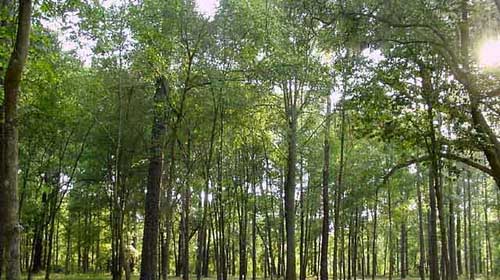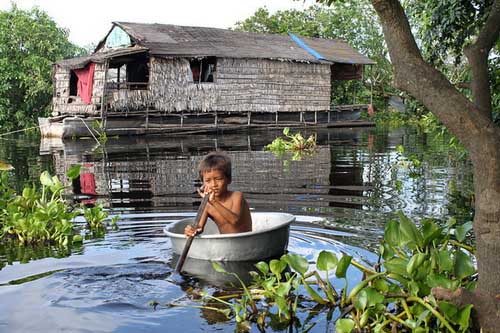10 'hot spots' about forest ecosystems
The United Nations has declared, 2011 is the international year of forests. In response to this event, the International Conservation Organization (CI) has just announced 10 "hotspots" of the world's threatened forest ecosystems to raise public awareness about the importance of forests and the it is necessary to protect them.
10 forest ecosystems were selected by CI with the goal of having 90% (or more) of their original habitats lost and each forest site must have at least 1,500 endemic plant species. If forests are lost, these endemic species will disappear forever. Notably, these 10 forest ecosystems support about 1 billion people living in or around them, directly or indirectly depending on the resources they provide.
Scientists also estimate that these 10 forest ecosystems can store over 25 billion tons of carbon, helping clean the air and deal with the inevitable impacts of climate change.

Forest is the source of livelihood for about 1.6 billion people - Photo: scienceblogs.com
CI said the forest only covers 30% of the total land area on Earth, but they are the 'home' of about 80% of the biodiversity on the planet. The plants, flowers, animals and microorganisms that live in the forest create a complex network of life.
Forests are also a source of livelihood for about 1.6 billion people. Specifically, according to National Geographic magazine (USA), forests provide wood, food, shelter, entertainment, fresh water for humans and prevent erosion.
However, Mr. Olivier Langrand - head of CI's international policy, said that the forest is being destroyed at an alarming rate to get agricultural land, mining and building areas. urban. The consequence is that the habitat is seriously affected: the fact that deforestation has emitted emissions accounting for 15% of global greenhouse gas emissions.
Here are 10 "hot spots" about forest ecosystems:
1. India - Myanmar


Photos: Sitha Som, CIARKIVE
The rivers and floodplains in India - Myanmar are important for the livelihoods of local people and in the conservation of birds, freshwater turtles and fish, including catfish. Mekong giant Pangasianodon gigas (photo below).
However, the ecosystem here is increasingly destroyed by the construction of hydroelectric dams, overexploitation of fisheries and also by people navigating the flow of rice and shrimp farming. Currently only about 5% of the living environment here is not affected by people.
2. New Island

Photo: Bruce Beehler, CI / ARKIVE
Located in the southernmost Pacific Ocean, about 1,200km from Australia to the southeast, Tan Dao is the 'home' of 5 endemic plants. However, the exploitation of nickel, deforestation and the occurrence of invasive species threatened the endemic flora and fauna here, including the endangered bird kagu Rhynochetos jubatus. The living environment unaffected by humans is only 5%.
3. Sundaland bio-region

Photo: Haroldo Castro, CI
Endemic flora and fauna in the Sundaland biogeographic region is 'suffering' from the growth of public and forestry trade and trade in animals, such as tigers, monkeys and turtles, catering to the demand for food. and medicine for other countries.
The population of orangutans (photos), found only in the forests of this area has been significantly reduced. There is only about 7% left here to keep the original habitat.
4. Philippines

Photo: Olivier Langrand, CI
With more than 7,100 islands, the Philippines is one of the world's most biodiverse countries and the "home" of many rare and precious animal and plant species, such as the Philippine eagle Pithecophaga jefferyi - the second largest eagle on the planet. Earth (photo).
However, the forests here are being cut down to get timber for houses, farms and to adapt to the situation of high population growth and poverty.
5. Atlantic coastal forest

Photo: Frans Lanting, National Geographic
The Atlantic coastal forest has about 20,000 species of plants and animals, of which 40% are endemic, but the primary forest here is less than 10%.
6. Mountains in southwest China

Photo: Piotr Naskrecki, CI
The southwestern Chinese mountain range supports the habitat for temperate flora in the world with most species being endemic. It is also home to the big panda Ailuropoda melanoleuca and its relatives are the red panda Ailurus fulgens (photo).
However, the construction of dams in the region's rivers has affected the ecosystem and the lives of millions of people. According to scientists, only 8% of the living environment in the area remains intact.
7. California flora area

Photo: William Crosse, CI
The flora of California is the 'home' of the giant limestone tree, thought to be the largest plant on the planet, and another species of the world's tallest tree is redwood, about 115m high (pictured). . Regional ecosystems are currently seriously threatened by deforestation for farms, expansion of urban areas, pollution and construction of road systems. The initial habitat here is only about 10%.
8. East African coastal forest (east of the African continent)

Photo: Getty Images
Although very small and fragmented, forests along the coast of East Africa (only 10% remain intact) contain considerable biodiversity. One of its endemic primates is the Procolobus kirkii monkey (pictured), which is estimated to be about 1,000 to 1,500 individuals. Agricultural expansion is a major threat to this region.
9. Madagascar and the islands of the Indian Ocean

Photo: National Geographic
This is a famous place with many lemurs, the island of Madagascar has more than 50 species. However, poverty and rapid population growth are putting enormous pressure on the environment in this place. Currently, the living environment is not affected by people here only about 10%.
10. Eastern Afromontane area

Photo: National Geographic
According to CI information, the threat to the area's living environment is agricultural expansion and forest meat trafficking. At present, the living environment here remains intact at 11%.
- VN strives to conserve diversity of forest ecosystems
- Wolves help protect threatened forest cats
- What is mangrove forest? Mangrove ecosystem in Vietnam
- Ecosystems of Southeast Asian countries viewed from satellites
- Hundred-year-old eco-forest in the village
- Satellite detection of forest fire
- The most exotic trees on Earth
- Giant black spots appeared on the sun
- 14-year-old girl invented how to eliminate blind spots on cars
- Why do nails have white spots, the reason is simple
- The creature is destroyed by drought
- Black spots appear on the skin, what is the cause?
 Is the magnetic North Pole shift dangerous to humanity?
Is the magnetic North Pole shift dangerous to humanity? Washington legalizes the recycling of human bodies into fertilizer
Washington legalizes the recycling of human bodies into fertilizer Lightning stone - the mysterious guest
Lightning stone - the mysterious guest Stunned by the mysterious sunset, strange appearance
Stunned by the mysterious sunset, strange appearance Inside Hoia Baciu - The World's Scariest Forest
Inside Hoia Baciu - The World's Scariest Forest  145 million year old fossil cypress forest along the English coast
145 million year old fossil cypress forest along the English coast  40,000-year-old fossil forest discovered after storm
40,000-year-old fossil forest discovered after storm  Fascinating beauty of Hue mangrove forest in leaf changing season
Fascinating beauty of Hue mangrove forest in leaf changing season  Australia's primeval forests died en masse due to drought and climate change
Australia's primeval forests died en masse due to drought and climate change  Video: Close-up of catching a giant cobra 4.6m long
Video: Close-up of catching a giant cobra 4.6m long 